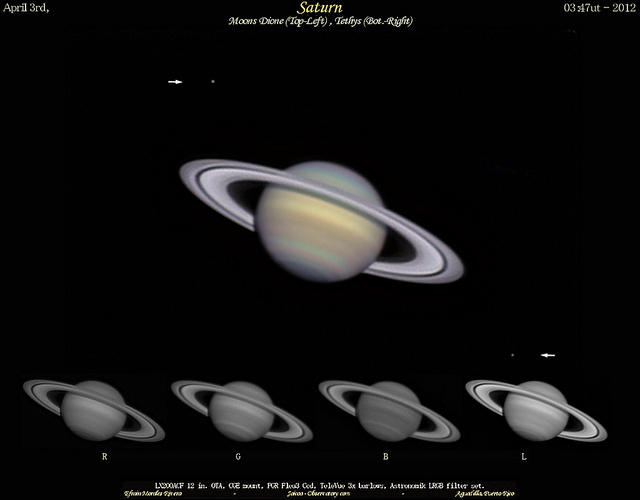[/caption]
Now is the time to take a look at the planet Saturn, as the ringed planet will be at opposition this weekend, making its closest approach to Earth on April 15, 2012. Its face will be fully illuminated by the Sun, so get out those telescopes, binoculars and your imaging equipment! We want to see your photos! Efrain Morales from the Jaicoa Observatory took this image of Saturn and some of its moons on April 3.
The giant planet’s rings are now optimally angled at over 13 degrees, revealing them better than they have appeared in the past five years. To see the rings of Saturn during opposition, in the northern hemisphere point your telescopes east to southeast at nightfall and south around midnight. For reference, Saturn will be near the bright star Spica, in the constellation Virgo. In the southern hemisphere, Saturn will be above the eastern horizon at 10pm local time, still near Spica.
If the skies aren’t clear in your area, the Slooh Space Observatory will broadcast a free, real-time feed of Saturn at opposition. Their coverage will begin on Sunday, April 15th, starting at 6:30 p.m. PDT/9:30 p.m. EDT/01:30 UTC (April 16th). Slooh will provide two distinct observatory feeds — one from a remote location in South Africa and the second from their world-class observatory site in Canary Islands off the coast of Africa. The broadcast can be accessed at Slooh’s homepage or by visiting Slooh’s Google+ page, where you will be able to see a panel of experts interact live via G+ Hangouts On Air.
The experts include Duncan Copp, producer of many astronomical documentaries, including “In the Shadow of the Moon”; Amanda Hendrix, Cassini’s deputy project scientist from NASA’s Jet Propulsion Laboratory; and Bob Berman, author of numerous astronomy books and contributing editor and monthly columnist for Astronomy Magazine.
“In 40 years of observing the heavens and watching people’s reactions to celestial glories, I’ve found that no object elicits more amazement and sheer wonder than Saturn. I am thrilled to be part of Slooh’s live close-up visit to that magnificent planet,” said Bob Berman.
Send us your images of Saturn by joining our Flickr group, or send us your images by email (this means you’re giving us permission to post them). Please explain when and where you took it, the equipment you used, etc.


Re: How to find Saturn in the sky this weekend: instructions here are for the northern parts of the world; for us in the south, reverse the instructions. ‘Twould be nice if you’d recognise that – being a global event and this site being available worldwide – different instructions for different locations would be (almost) a natural priority for the dissemination of your passion.
You’re right…. have added a note about the two hemispheres.
Thanks Nancy; greatly appreciated. Saturn was quite splendid last night (Saturday) in cloudless dark skies at Portsea, on the coast of Southern Victoria ( Australia). Keep up the good work, and continue to be aware that many of us in the south love the Universe Today site.